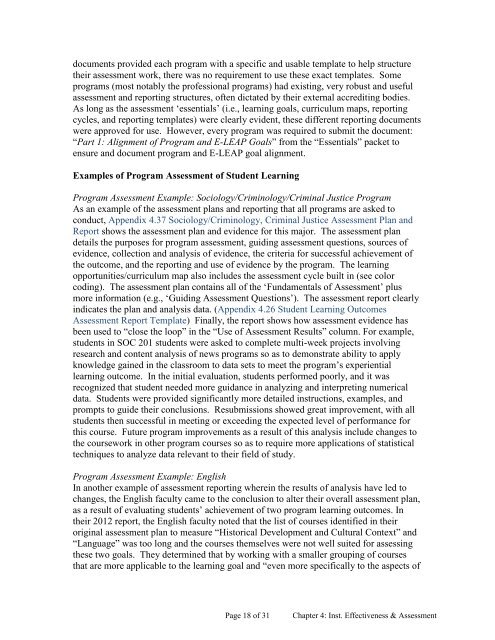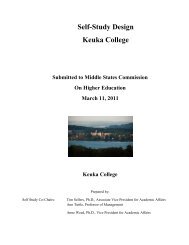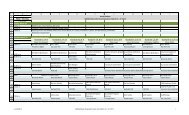final version of the self-study document - Keuka College's Middle ...
final version of the self-study document - Keuka College's Middle ...
final version of the self-study document - Keuka College's Middle ...
You also want an ePaper? Increase the reach of your titles
YUMPU automatically turns print PDFs into web optimized ePapers that Google loves.
<strong>document</strong>s provided each program with a specific and usable template to help structure<br />
<strong>the</strong>ir assessment work, <strong>the</strong>re was no requirement to use <strong>the</strong>se exact templates. Some<br />
programs (most notably <strong>the</strong> pr<strong>of</strong>essional programs) had existing, very robust and useful<br />
assessment and reporting structures, <strong>of</strong>ten dictated by <strong>the</strong>ir external accrediting bodies.<br />
As long as <strong>the</strong> assessment ‘essentials’ (i.e., learning goals, curriculum maps, reporting<br />
cycles, and reporting templates) were clearly evident, <strong>the</strong>se different reporting <strong>document</strong>s<br />
were approved for use. However, every program was required to submit <strong>the</strong> <strong>document</strong>:<br />
“Part 1: Alignment <strong>of</strong> Program and E-LEAP Goals” from <strong>the</strong> “Essentials” packet to<br />
ensure and <strong>document</strong> program and E-LEAP goal alignment.<br />
Examples <strong>of</strong> Program Assessment <strong>of</strong> Student Learning<br />
Program Assessment Example: Sociology/Criminology/Criminal Justice Program<br />
As an example <strong>of</strong> <strong>the</strong> assessment plans and reporting that all programs are asked to<br />
conduct, Appendix 4.37 Sociology/Criminology, Criminal Justice Assessment Plan and<br />
Report shows <strong>the</strong> assessment plan and evidence for this major. The assessment plan<br />
details <strong>the</strong> purposes for program assessment, guiding assessment questions, sources <strong>of</strong><br />
evidence, collection and analysis <strong>of</strong> evidence, <strong>the</strong> criteria for successful achievement <strong>of</strong><br />
<strong>the</strong> outcome, and <strong>the</strong> reporting and use <strong>of</strong> evidence by <strong>the</strong> program. The learning<br />
opportunities/curriculum map also includes <strong>the</strong> assessment cycle built in (see color<br />
coding). The assessment plan contains all <strong>of</strong> <strong>the</strong> ‘Fundamentals <strong>of</strong> Assessment’ plus<br />
more information (e.g., ‘Guiding Assessment Questions’). The assessment report clearly<br />
indicates <strong>the</strong> plan and analysis data. (Appendix 4.26 Student Learning Outcomes<br />
Assessment Report Template) Finally, <strong>the</strong> report shows how assessment evidence has<br />
been used to “close <strong>the</strong> loop” in <strong>the</strong> “Use <strong>of</strong> Assessment Results” column. For example,<br />
students in SOC 201 students were asked to complete multi-week projects involving<br />
research and content analysis <strong>of</strong> news programs so as to demonstrate ability to apply<br />
knowledge gained in <strong>the</strong> classroom to data sets to meet <strong>the</strong> program’s experiential<br />
learning outcome. In <strong>the</strong> initial evaluation, students performed poorly, and it was<br />
recognized that student needed more guidance in analyzing and interpreting numerical<br />
data. Students were provided significantly more detailed instructions, examples, and<br />
prompts to guide <strong>the</strong>ir conclusions. Resubmissions showed great improvement, with all<br />
students <strong>the</strong>n successful in meeting or exceeding <strong>the</strong> expected level <strong>of</strong> performance for<br />
this course. Future program improvements as a result <strong>of</strong> this analysis include changes to<br />
<strong>the</strong> coursework in o<strong>the</strong>r program courses so as to require more applications <strong>of</strong> statistical<br />
techniques to analyze data relevant to <strong>the</strong>ir field <strong>of</strong> <strong>study</strong>.<br />
Program Assessment Example: English<br />
In ano<strong>the</strong>r example <strong>of</strong> assessment reporting wherein <strong>the</strong> results <strong>of</strong> analysis have led to<br />
changes, <strong>the</strong> English faculty came to <strong>the</strong> conclusion to alter <strong>the</strong>ir overall assessment plan,<br />
as a result <strong>of</strong> evaluating students’ achievement <strong>of</strong> two program learning outcomes. In<br />
<strong>the</strong>ir 2012 report, <strong>the</strong> English faculty noted that <strong>the</strong> list <strong>of</strong> courses identified in <strong>the</strong>ir<br />
original assessment plan to measure “Historical Development and Cultural Context” and<br />
“Language” was too long and <strong>the</strong> courses <strong>the</strong>mselves were not well suited for assessing<br />
<strong>the</strong>se two goals. They determined that by working with a smaller grouping <strong>of</strong> courses<br />
that are more applicable to <strong>the</strong> learning goal and “even more specifically to <strong>the</strong> aspects <strong>of</strong><br />
Page 18 <strong>of</strong> 31 Chapter 4: Inst. Effectiveness & Assessment




